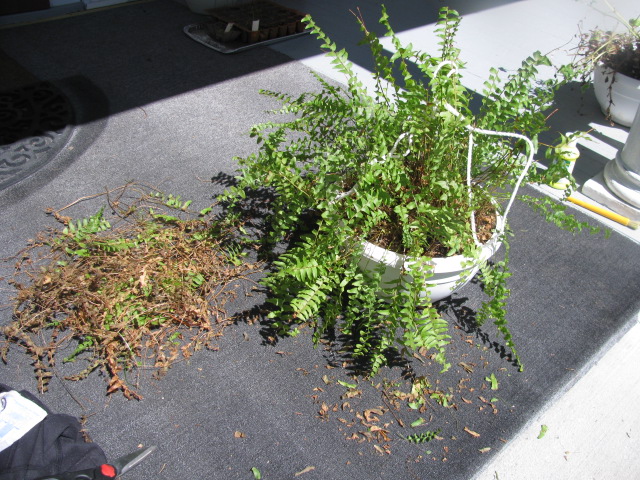Understanding Boston Ferns’ Sensitivity to Cold Temperatures
Boston ferns, native to the tropical regions of the Americas, are popular houseplants known for their lush, green foliage and delicate fronds. However, their natural habitat is far removed from the cold temperatures and harsh winters experienced in many parts of the world. As a result, Boston ferns are sensitive to cold temperatures and require special care to survive the winter months.
Can Boston ferns survive winter? The answer is yes, but only if they are properly protected from frost and freezing temperatures. Boston ferns thrive in temperatures between 65°F to 75°F (18°C to 24°C), making them ideal for indoor spaces with consistent temperatures. However, when exposed to temperatures below 50°F (10°C), the plants begin to suffer, and prolonged exposure can lead to damage or even death.
The sensitivity of Boston ferns to cold temperatures is due to their tropical origins. In their natural habitat, Boston ferns grow in shaded, humid environments with consistent temperatures, making them ill-equipped to handle the sudden changes in temperature and humidity that come with winter. As a result, it is essential to take steps to protect Boston ferns from cold temperatures, such as bringing them indoors or using protective coverings, to ensure their survival.
By understanding the natural habitat and sensitivity of Boston ferns to cold temperatures, you can take the necessary steps to protect your plants and ensure they thrive year-round. In the following sections, we will explore the essential tips for preparing your Boston fern for winter, protecting it from frost and freezing temperatures, and providing the necessary care to keep it healthy and resilient during the cold months.
Preparing Your Boston Fern for Winter: Essential Tips
To ensure your Boston fern remains healthy and resilient during the cold months, it’s essential to prepare it for winter. One of the most critical steps is to prune your Boston fern before the winter season. Pruning helps to remove dead or damaged fronds, promoting healthy growth and preventing the spread of disease. Use a pair of clean, sharp scissors or pruning shears to remove any dead or damaged fronds, cutting them off at the base.
Fertilizing your Boston fern is also crucial before the winter season. Feed your plant with a balanced, water-soluble fertilizer (20-20-20) to provide essential nutrients for healthy growth. Dilute the fertilizer to half the recommended strength to avoid burning the roots. Apply the fertilizer once a month, starting in the fall, to promote healthy growth and development.
Repotting your Boston fern is another essential step to prepare it for winter. Boston ferns typically need to be repotted every 1-2 years, as their potting mix breaks down over time. Choose a well-draining potting mix specifically designed for ferns, and a pot that is only slightly larger than the previous one. Repotting your Boston fern in the fall will give it a fresh start and provide the necessary nutrients for healthy growth during the winter months.
In addition to pruning, fertilizing, and repotting, it’s also essential to inspect your Boston fern for any pests or diseases before the winter season. Check for any signs of spider mites, mealybugs, or scale, and treat your plant accordingly. Regularly inspecting your plant will help prevent any potential problems and ensure it remains healthy and thriving.
By following these essential tips, you can help your Boston fern prepare for the winter season and ensure it remains healthy and resilient. Remember, with proper care and attention, Boston ferns can survive and thrive even in the coldest of winters. In the next section, we will discuss how to protect your Boston fern from frost and freezing temperatures.
How to Protect Your Boston Fern from Frost and Freezing Temperatures
Protecting your Boston fern from frost and freezing temperatures is crucial to ensure its survival during the winter months. One of the most effective ways to protect your Boston fern is to bring it indoors. If possible, move your Boston fern to a bright, sunny location with temperatures between 65°F to 75°F (18°C to 24°C). This will provide your plant with the necessary warmth and light to thrive during the winter.
If bringing your Boston fern indoors is not feasible, you can use frost blankets to protect it from frost and freezing temperatures. Frost blankets are lightweight, breathable covers that can be placed over your plant to trap warmth and protect it from cold temperatures. You can also use burlap or a sheet to cover your plant, but make sure to remove it during the day to allow for air circulation and prevent moisture buildup.
Another option is to use cold frames or greenhouses to protect your Boston fern from frost and freezing temperatures. Cold frames are structures that cover your plant with a clear or translucent top, allowing sunlight to enter while keeping cold temperatures out. Greenhouses provide a more extensive protection, offering a warm and humid environment for your plant to thrive.
When using any of these methods, make sure to monitor your Boston fern’s temperature and adjust as necessary. Boston ferns can tolerate some frost, but prolonged exposure to freezing temperatures can cause damage or death. By taking the necessary precautions, you can help your Boston fern survive the winter months and thrive year-round.
It’s also essential to note that Boston ferns can be sensitive to wind, so if you live in an area with high winds, consider providing additional protection, such as a windbreak or a sheltered location. By providing the necessary protection, you can help your Boston fern survive the winter months and enjoy its beautiful foliage year-round.
Indoor Care for Boston Ferns During Winter
When bringing your Boston fern indoors for the winter, it’s essential to provide the right conditions for it to thrive. Lighting is one of the most critical factors to consider. Boston ferns prefer bright, indirect light, but direct sunlight can be too intense for them. Place your Boston fern near an east- or west-facing window, or use a sheer curtain to filter the sunlight.
Watering is also crucial during the winter months. Boston ferns prefer moist soil, but overwatering can be detrimental. Check the soil moisture by sticking your finger into the soil up to the first knuckle. If the soil feels dry, it’s time to water. Water your Boston fern thoroughly, making sure the pot drains well to prevent waterlogged soil.
Humidity is another essential factor to consider when caring for your Boston fern indoors. Boston ferns thrive in humid environments, typically between 40-60% relative humidity. You can increase the humidity around your plant by placing it on a tray filled with water and pebbles or using a humidifier.
Temperature is also critical when caring for your Boston fern indoors. Keep your Boston fern in a room with a consistent temperature between 65°F to 75°F (18°C to 24°C). Avoid placing your Boston fern near heating or cooling vents, fireplaces, or drafty windows, as this can cause temperature fluctuations.
Finally, fertilization is essential during the winter months. Feed your Boston fern with a balanced, water-soluble fertilizer (20-20-20) once a month. Dilute the fertilizer to half the recommended strength to prevent burning the roots.
By providing the right conditions, including lighting, watering, humidity, temperature, and fertilization, you can help your Boston fern thrive indoors during the winter months. Remember, with proper care and attention, Boston ferns can survive and thrive even in the coldest of winters.
Common Mistakes to Avoid When Winterizing Your Boston Fern
When winterizing your Boston fern, it’s essential to avoid common mistakes that can harm or kill your plant. One of the most critical mistakes is exposing your Boston fern to extreme temperatures. Boston ferns are sensitive to cold temperatures, and exposure to frost or freezing temperatures can cause damage or death. Make sure to bring your Boston fern indoors or provide protection from frost and freezing temperatures.
Overwatering is another common mistake to avoid when winterizing your Boston fern. Boston ferns prefer moist soil, but overwatering can cause root rot and other problems. Check the soil moisture regularly, and avoid watering your Boston fern during the winter months unless the soil feels dry to the touch.
Neglecting to provide sufficient humidity is also a common mistake to avoid when winterizing your Boston fern. Boston ferns thrive in humid environments, typically between 40-60% relative humidity. Use a humidifier or place your Boston fern on a tray filled with water and pebbles to increase the humidity around your plant.
Another mistake to avoid is fertilizing your Boston fern during the winter months. Boston ferns are dormant during the winter, and fertilizing can cause new growth that may not be able to withstand the cold temperatures. Wait until the spring to fertilize your Boston fern, when it begins to produce new growth.
Finally, neglecting to monitor your Boston fern’s condition during the winter months is a common mistake to avoid. Check your Boston fern regularly for signs of pests, diseases, or nutrient deficiencies, and take action promptly if you notice any problems.
By avoiding these common mistakes, you can help your Boston fern survive and thrive during the winter months. Remember, with proper care and attention, Boston ferns can survive and thrive even in the coldest of winters.
Reviving Your Boston Fern After a Harsh Winter
If your Boston fern has suffered damage or decline after a harsh winter, don’t worry With proper care and attention, you can revive your plant and help it recover and thrive. One of the first steps is to prune your Boston fern to remove any dead or damaged fronds. This will help to promote healthy growth and prevent the spread of disease.
Next, fertilize your Boston fern with a balanced, water-soluble fertilizer (20-20-20) to provide essential nutrients for healthy growth. Dilute the fertilizer to half the recommended strength to avoid burning the roots. Apply the fertilizer once a month, starting in the spring, to promote healthy growth and development.
Repotting your Boston fern may also be necessary after a harsh winter. If the soil has broken down or the plant has outgrown its container, repot your Boston fern in the spring using a well-draining potting mix specifically designed for ferns. Choose a pot that is only slightly larger than the previous one to prevent the soil from becoming too wet.
In addition to pruning, fertilizing, and repotting, make sure to provide your Boston fern with the right conditions to recover and thrive. This includes providing bright, indirect light, maintaining a consistent temperature between 65°F to 75°F (18°C to 24°C), and keeping the humidity level between 40-60% relative humidity.
By following these steps, you can help your Boston fern recover and thrive after a harsh winter. Remember, with proper care and attention, Boston ferns can survive and thrive even in the coldest of winters.
Choosing the Right Variety of Boston Fern for Your Climate
When it comes to choosing the right variety of Boston fern for your climate, there are several factors to consider. Boston ferns are generally sensitive to cold temperatures, but some varieties are more cold-hardy than others. If you live in an area with harsh winters, you’ll want to choose a variety that can withstand the cold.
One popular variety of Boston fern that is known for its cold hardiness is the ‘Austral Gem’ variety. This variety is native to Australia and is known for its ability to tolerate temperatures as low as 40°F (4°C). Another variety that is known for its cold hardiness is the ‘Rochford’ variety, which can tolerate temperatures as low as 30°F (-1°C).
On the other hand, if you live in an area with mild winters, you may want to choose a variety that is more sensitive to cold temperatures. The ‘Bostoniensis’ variety is a popular choice for its delicate, lacy fronds and is known for its ability to thrive in temperatures between 50°F (10°C) and 70°F (21°C).
Ultimately, the best variety of Boston fern for your climate will depend on your specific needs and preferences. By choosing a variety that is well-suited to your climate, you can help ensure that your Boston fern thrives year-round.
In addition to choosing the right variety, it’s also important to consider the specific growing conditions in your area. Boston ferns prefer bright, indirect light and consistent temperatures between 65°F (18°C) and 75°F (24°C). They also prefer high humidity, typically between 40-60% relative humidity.
By choosing the right variety and providing the right growing conditions, you can help your Boston fern thrive year-round, even in the coldest of winters.
Conclusion: With Proper Care, Boston Ferns Can Thrive Year-Round
In conclusion, Boston ferns can be a beautiful and rewarding addition to any home or garden, but they do require special care to survive the winter months. By understanding the natural habitat of Boston ferns and their sensitivity to cold temperatures, you can take the necessary steps to protect them from frost and freezing temperatures.
By following the tips and advice outlined in this article, you can help your Boston fern thrive year-round, even in the coldest of winters. Remember to prepare your Boston fern for winter by pruning, fertilizing, and repotting, and to protect it from frost and freezing temperatures using frost blankets, bringing plants indoors, or using cold frames or greenhouses.
When keeping your Boston fern indoors during the winter, make sure to provide the right conditions, including bright, indirect light, consistent temperatures, and high humidity. Avoid common mistakes such as exposing your Boston fern to extreme temperatures, overwatering, or neglecting to provide sufficient humidity.
With proper care and attention, Boston ferns can survive and thrive even in the coldest of winters. By choosing the right variety of Boston fern for your climate and providing the right growing conditions, you can enjoy the beauty and benefits of these plants year-round.
Can Boston ferns survive winter? With the right care and attention, the answer is yes. By following the tips and advice outlined in this article, you can help your Boston fern thrive year-round and enjoy its beauty and benefits for years to come.





